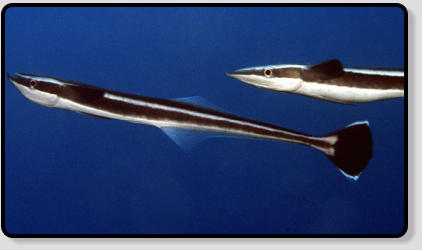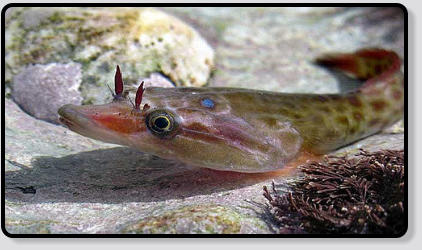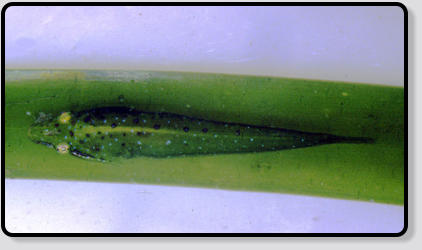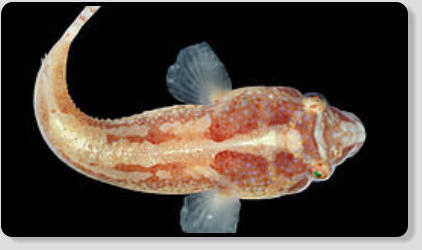Scientific classification
Kingdom:
Phylum:
Chordata
Class:
Actinopterygii
Order:
Perciformes
Family:
Echeneidae
Genus:
Echeneis
Species:
E. Naucrates
Binomial name (link Wikipedia)




Live Sharksucker
Remora
Schiffshalter
Rémora
Zebra Remora

Description
Length: up to 1 metre.
Habitat: pelagic.
Echeneis naucrates is a medium-sized fish which can grow up 110 cm (43 in) length. Its body is elongated and streamlined, and its
lower jaw is clearly prognathic(it projects forward well beyond the upper jaw). The jaws, vomer and tongue have villiform teeth. The
main distinctive feature to distinguish from other fishes is the oval-shaped sucking disc, which is a highly modified dorsal fin
positioned from the top of the head to the anterior part of the body.
The body background colouration is dark grey to dark brown, with a dark belly. A longitudinal stripe runs along the axis side of the
body, it is always darker than its background colourwith a whitish margin. The caudal fin is black with white corners.
The species is considered as circumtropical, as it occurs in all tropical and warm temperate waters around the world.
The species can be found close to the coast, as well as offshore at a maximum depth of 50 m (160 ft).
A live sharksucker is known to attach itself temporarily by its modified dorsal fin used as a sucking disc to various hosts, such as
sharks, rays, large bony fishes, sea turtles, whales, dolphins, ships, and even sometimes scubadivers.

Animalia
Scientific classification
Kingdom:
Phylum:
Chordata
Class:
Actinopterygii
Order:
Perciformes
Family:
Echeneidae
Genus:
Remora
Species:
R. Remora
Binomial name (link Wikipedia)




Common Remora
Remora
Schiffshalter
Rémora
Remora

Description
Length: up to 70 cm.
Habitat: pelagic.
The common remora, Remora remora, is a pelagic marine fish belonging to family Echeneidae. R. remora is different from other
remoras in the family Echeneidae by the modification of its dorsal fin. The dorsal fin, which has 22 to 26 soft rays, acts as a suction
cup, creating a vacuum to allow it to attach to larger marine animals, such as whales, dolphins, sharks, and sea turtles.
The common remora has a suckerlike dorsal fin and an anal fin. Its body can be brown, black or grey in color. This species can reach
86.4 cm (34.0 in) in total length, though most do not exceed 40 cm (16 in). The maximum known weight of this species is 1.1 kg (2.4 lb).
R. remora and its host seem to partake in a symbiotic relationship; the common remora does not seem to have a negative overall
effect on its host. The host provides the remora with fast-moving water to bathe its gills, a steady flow of food, transportation, and
protection. The remora benefits the host by feeding in part on some of its parasites, but increases its hydrodynamical drag. The
common remora's attachment to one host can last for up to three months. During this time, the remora can move its attachment site if
it feels threatened. The common remora cannot survive in still water; it needs water flow over its gills to provide it oxygen.
Animalia
Scientific classification
Kingdom:
Phylum:
Chordata
Class:
Actinopterygii
Order:
Gobiesociformes
Family:
Gobiesocidae
Genus:
Lepadogaster
Species:
L. Lepadogaster
Binomial name (link Wikipedia)




Shore Clingfish
Poisson Ventouse
Ansauger
Pez Ventosa
Gevlekte zuignapvis

Description
Length: average length 5 cm.
Habitat: Rocky bottoms, but generally under stones.
The shore clingfish, Lepadogaster lepadogaster, is a clingfish of the family Gobiesocidae, found in the eastern Atlantic from Ireland
and Britain, where it is more commonly known as the Cornish lumpsucker, and in the Mediterranean, between latitudes 46° N and 30°
N. L. lepadogaster often inhabits underwater boulder fields consisting of smooth rocks and large pebbles. Its length is up to 65 mm. L.
lepadogaster is also classified as a cryptobenthic fish. Cryptobenthic simply means that the fish is both behaviorally and visually
cryptic. The term is also used mainly to describe adult fish of a certain size, roughly around 5cm in length.
The clingfish gets its name from the ability of the fish to attach itself to the rock walls of the ocean shore. It does this by having pelvic
fins that have been adapted to form suckers. These suckers keep the clingfish strongly attached to the rocky surfaces off the
shorelines. In addition to these suckers, the front fins of the clingfish are much stronger to aid in clinging to the rocks.
The clingfish has other adaptations that allow it to inhabit rocky surfaces and reduce predation. For instance, the clingfish has a
triangular shaped head and a flattened body. These characteristics allow the clingfish to reduce the drag of the water from the waves
pushing and pulling against it. L. lepadogaster also has distinct differences from the other species of Lepadogaster. For one, L.
lepadogaster has a much more active lifestyle than the species "L. purpurea. This is evident in both L. lepadogaster's swimming speed
and in its more frequent feeding periods
The cornish lumpsucker survives by consisting on a diet of mostly detritus material, meaning that it lives off the dead organic matter
of its environment.
Animalia


Categories: Remora & Clingfish




Kingdom:
Phylum:
Chordata
Class:
Actinopterygii
Order:
Gobiesociformes
Family:
Gobiesocidae
Genus:
Opeatogenys
Species:
O. Cadeneti
Opeatogenys Cadeneti
Binomial name




Clingfish
Poisson Ventouse
Ansauger
Pez Ventosa
Schildvis (groen)

Description
Length: 3 cm.
Habitat: sea grass meadows, where it is perfectly camouflaged.
No further information available on Wikipedia.
Animalia
Scientific classification
Kingdom:
Phylum:
Chordata
Class:
Actinopterygii
Order:
Gobiesociformes
Family:
Gobiesocidae
Genus:
Opeatogenys
Species:
D. Ctenocrypta
Diplecogaster Ctenocrypta
Binomial name




Clingfish
Poisson Ventouse
Ansauger
Pez Ventosa
Schildvis (rood/oranje)

Description
Length: 3 cm.
Habitat: rocky bottoms.
No further information available on Wikipedia.
Animalia
Harry van Goor 2016
source: Wikipedia, the free encyclopedia




